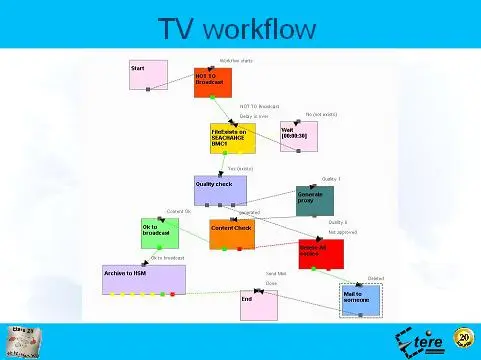Media and Metadata Management on Tapeless Digital Systems
08 February 2010BES EXPO Conference 2010, Speaker: Fabio Gattari, Title: Metadata Management on Tapeless Digital TV
One of the main broadcaster's challenges today, is tapeless approach.
The implementation of a media management system that could be modular, interoperable, workflow-based and cost-effective at the same time is the real challenge.
Digital TV requires more metadata attached to the video, as Epg, Multilanguage subtitles, aspect ratio conversion, and broadcasted at the same time.
But the big challenge is the paperless approach; its not possible to attach a paper to a file, so all the paper based steps must be changed to digital based steps.
This document provides a description of the implementation of media solutions completely based on digital workflows, with a focus on the importance of metadata in a tapeless, digital environment.
Tapeless cuts the cost in all the TV areas from production, to approval and broadcast, but also retrieve ad
repurpose old content is extremely simple using the tapeless approach.
But tapeless change the organization of a broadcaster. If you run a tour in very broadcast station today you see two objects. - Tapes
- Paper
While tapes are easy replaced in a tapeless system, paper is harder to change. You cannot attach a paper to a file, this simple rule say also you cannot use a different system to produce the paper metadata but you need to move everyone to a single metadata and file management system.
Metadata cannot be attached to a file and the different video files wrapper you need to use cannot carry all the metadata you need inside, so only a MAM system can handle the correct links between all the metadata.
Epg data is an example, Epg is developed at production site and its linked to the product for all its life.
Rights information also, but those can change while the video content is the same, only a MAM can give you all the links you need.
but also satellite, DTT, DTH, internet and more.
All with different video formats, metadata inclusion, rights management, this require an efficient connection
between the MAM data and the 'playout system'.
As an example if the same video must be broadcasted on DTT channel and streamed to internet MAM
workflow must drive multiple tasks
Find the MXF 50 megabit copy and deliver to DTT playout
Find or create the wmv copy and deliver it to the internet streaming
Deliver Epg data to the Epg system of DTT including program classification.
Deliver Epg data to the HTML creator of internet metadata page, including eventually limited rights for some
users worldwide so they cannot stream it.
suppliers, the challenge here is how to really integrate them so they can work well.
One of the key of success in this area is the 'keep simple' rule, try to reduce the number of company/products to connect, the loose of performance you have every time you connect two different product can destroy the system you create using a lot of 'best of the breed' products.
While a similar system using fewer products but with less interfaces can produce a really working system.
Moving to tapeless is the core of a digital TV. Tapeless cuts the cost in all the TV areas from production, to approval and broadcast, but also retrieve ad repurpose old content is extremely simple using the tapeless approach. But tapeless change the organization of a broadcaster. If you run a tour in very broadcast station today you see two objects. - Tapes - Paper While tapes are easy replaced in a tapeless system, paper is harder to change. You cannot attach a paper to a file, this simple rule say also you cannot use a different system to produce the paper metadata but you need to move everyone to a single metadata and file management system. Metadata cannot be attached to a file and the different video files wrapper you need to use cannot carry all the metadata you need inside, so only a MAM system can handle the correct links between all the metadata. Epg data is an example, Epg is developed at production site and its linked to the product for all its life. Rights information also, but those can change while the video content is the same, only a MAM can give you all the links you need.
Now one step further, Digital TV has more broadcasting scheme then before, you have analogue broadcast but also satellite, DTT, DTH, internet and more. All with different video formats, metadata inclusion, rights management, this require an efficient connection between the MAM data and the 'playout system'. As an example if the same video must be broadcasted on DTT channel and streamed to internet MAM workflow must drive multiple tasks Find the MXF 50 megabit copy and deliver to DTT playout Find or create the wmv copy and deliver it to the internet streaming Deliver Epg data to the Epg system of DTT including program classification. Deliver Epg data to the HTML creator of internet metadata page, including eventually limited rights for some users worldwide so they cannot stream it.
As it's clear a Mam for digital TV includes several features often delivered by different products of different suppliers, the challenge here is how to really integrate them so they can work well. One of the key of success in this area is the 'keep simple' rule, try to reduce the number of company/products to connect, the loose of performance you have every time you connect two different product can destroy the system you create using a lot of 'best of the breed' products. While a similar system using fewer products but with less interfaces can produce a really working system.
Digital TV creates new challenges for broadcasters but with a good technical background ad a wise choice of products they can drive the new digital era.
 Back
Back



